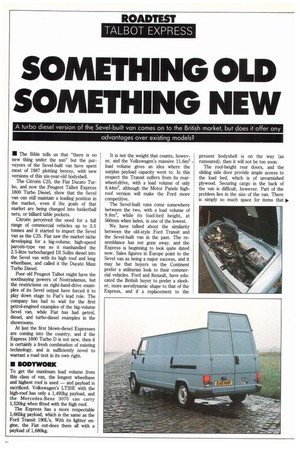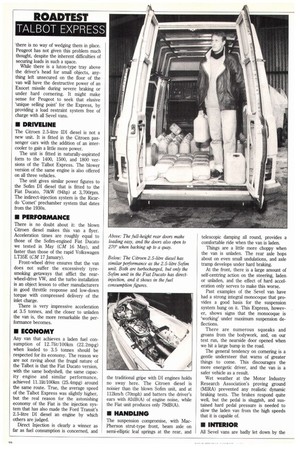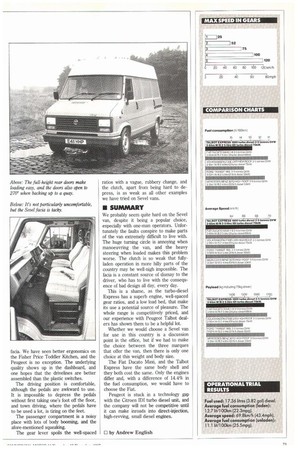SOMETHING OLD SOMETHING NEW
Page 80

Page 82

Page 83

If you've noticed an error in this article please click here to report it so we can fix it.
A turbo diesel version of the Sevel-built van comes on to the British market, but does it offer any advantages over existing models?
• The Bible tells us that "there is no new thing under the sun" but the purveyors of the Sevel-built van have spent most of 1987 plotting heresy, with new versions of this six-year-old bodyshell.
The Citroen C25, the Fiat Ducato Turbo, and now the Peugeot Talbot Express 1800 Turbo Diesel, show that the Sevel van can still maintain a leading position in the market, even if the goals of that market are being changed into basketball nets, or billiard table pockets.
Citroen perceived the need for a full range of commercial vehides up to 3.5 tonnes and it started to import the Sevel van as the C25. Fiat saw the market niche developing for a big-volume, high-speed parcels-type van so it manhandled the 2.5-litre turbocharged DI Sofirn diesel into the Sevel van with its high roof and long wheelbase, and called it the Ducato Maxi Turbo Diesel.
Poor old Peugeot Talbot might have the soothsaying powers of Nostradamus, but the restrictions on right-hand-drive examples of its Sevel output have forced it to play down stage to Fiat's lead role. The company has had to wait for the first petrol-engined examples of the big-volume Sevel van, while Fiat has had petrol, diesel, and turbo-diesel examples in the showrooms.
At last the first blown-diesel Expresses are coming into the country, and if the Express 1800 Turbo D is not new, then it is certainly a fresh combination of existing technology, and is sufficiently novel to warrant a road test in its own right.
• BODYWORK
To get the maximum load volume from this class of van, the longest wheelbase and highest roof is used — and payload is sacrificed. Volkswagen's LT35E with the high-roof has only a 1,492kg payload, and the Mercedes-Benz 3070 can carry 1,520kg when fitted with the high roof.
The Express has a more respectable 1,665kg payload, which is the same as the Ford Transit 190L's. With its lighter engine, the Fiat out-does them all with a payload of 1,680kg. It is not the weight that counts, however, and the Volkswagen's massive 11.6m3 • load volume gives an idea where the surplus payload capacity went to. In this respect the Transit suffers from its rearwheel-drive, with a load volume of only 8.44m3, although the Motor Panels highroof version will make the Ford more competitive.
The Sevel-built vans come somewhere between the two, with a load volume of 9.8m3, while its load-bed height, at 560mm when laden, is one of the lowest We have talked about the similarity between the old-style Ford Transit and the Sevel-built van in the past. The resemblance has not gone away, and the Express is beginning to look quite dated now. Sales figures in Europe point to the Sevel van as being a major success, and it may be that buyers on the Continent prefer a utilitarian look to their commercial vehicles. Ford and Renault, have educated the British buyer to prefer a sleeker, more aerodynamic shape to that of the Express, and if a replacement to the present bodyshell is on the way (as rumoured), then it will not be too soon.
The roof-height rear doors, and the sliding side door provide ample access to the load bed, which is of unvarnished plywood. Securing cargo in the back of the van is difficult, however. Part of the problem lies in the size of the van. There is simply so much space for items that pi. 'there is no way of wedging them in place. Peugeot has not given this problem much thought, despite the inherent difficulties of securing loads in such a space.
While there is a luton-type tray above the driver's head for small objects, anything left unsecured on the floor of the van will have the destructive power of an Exocet missile during severe braking or under hard cornering. It might make sense for Peugeot to seek that elusive 'unique selling point' for the Express, by providing a load restraint system free of charge with all Sevel vans.
• DRIVELINE
The Citroen 2.5-litre IDI diesel is not a new unit. It is fitted in the Citroen passenger cars with the addition of an intercooler to gain a little more power.
The unit is fitted in naturally-aspirated form to the 1400, 1500, and 1800 versions of the Talbot Express. The blower version of the same engine is also offered on all three vehicles.
The unit gives similar power figures to the Sofim DI diesel that is fitted to the Fiat Ducato, 70kW (94hp) at 3,700rpm. The indirect-injection system is the Ricardo 'Comet' prechamber system that dates from the 1930s.
• PERFORMANCE
There is no doubt about it: the blown Citroen diesel makes this van a flyer. Acceleration times are roughly equal to those of the Sofim-engined Fiat Ducato we tested in May (CM 16 May), and faster than those of the rapid Volkswagen LT35E (CM 17 January).
Front-wheel drive ensures that the van does not suffer the excessively tyresmoking getaways that afflict the rearwheel-drive VW, and the turbo installation is an object lesson to other manufacturers in good throttle response and low-down torque with compressed delivery of the inlet charge.
There is very impressive acceleration at 3.5 tonnes, and the closer to unladen the van is, the more remarkable the performance becomes.
• ECONOMY
Any van that achieves a laden fuel consumption of 12.71it/100km (22.2mpg) when loaded to 3.5 tonnes should be respected for its economy. The reason we are not raving about the frugal nature of the Talbot is that the Fiat Ducato version, with the same bodyshell, the same capacity engine and similar performance, achieved 11.11ft/1001cm (25.4mpg) around the same route. True, the average speed of the Talbot Express was slightly higher, but the real reason for the astonishing economy of the Fiat is the injection system that has also made the Ford Transit's 2.5-litre DI diesel an engine by which others are judged.
Direct Injection is clearly a winner as far as fuel consumption is concerned, and the traditional gripe with DI engines holds no sway here. The Citroen diesel is noisier than the blown Sofim unit, and at 1121cm/h (70mph) and batters the driver's ears with 82dB(A) of engine noise, while the Fiat unit produces only 79dB(A).
• HANDLING
The suspension compromise, with MacPherson strut-type front, beam axle on semi-elliptic leaf springs at the rear, and telescopic damping all round, provides a comfortable ride when the van is laden.
Things are a little more choppy when the van is unladen. The rear axle hops about on even small undulations, and axle tramp develops under hard braking.
At the front, there is a large amount of self-centring action on the steering, laden or unladen, and the effect of hard acceleration only serves to make this worse.
Past examples of the Sevel van have had a strong integral monocoque that provides a good basis for the suspension system hung on it. This Express, however, shows signs that the monocoque is 'working' under maximum suspension deflections.
There are numerous squeaks and groans from the bodywork, and, on our test run, the nearside door opened when we hit a large bump in the road.
The general tendency on cornering is a gentle understeer that warns of greater things to come. This discourages the more energetic driver, and the van is a safer vehicle as a result.
Wet weather at the Motor Industry Research Association's proving ground (MIRA) prevented any realistic dynamic braking tests. The brakes respond quite well, but the pedal is sluggish, and sustained hard pedal pressure is needed to slow the laden van from the high speeds that it is capable of.
• INTERIOR
I All Sevel vans are badly let down by the facia. We have seen better ergonomics on the Fisher Price Toddler Kitchen, and the Peugeot is no exception. The underlying quality shows up in the dashboard, and one hopes that the drivelines are better assembled than the plastic switches.
The driving position is comfortable, although the pedals are awkward to use. It is impossible to depress the pedals without first taking one's foot off the floor, and town driving, where the pedals have to be used a lot, is tiring on the feet.
The passenger compartment is a noisy place with lots of body booming, and the afore-mentioned squeaking.
The gear lever spoils the well-spaced ratios with a vague, rubbery change, and the clutch, apart from being hard to depress, is as weak as all other examples we have tried on Sevel vans.
• SUMMARY
We probably seem quite hard on the Sevel van, despite it being a popular choice, especially with one-man operators. Unfortunately the faults conspire to make parts of the van extremely difficult to live with. The huge turning circle is annoying when manoeuvring the van, and the heavy steering when loaded makes this problem worse. The clutch is so weak that fullyladen operation in more hilly parts of the country may be well-nigh impossible. The facia is a constant source of dismay to the driver, who has to live with the consequence of bad design all day, every day.
This is a shame, as the turbo-diesel Express has a superb engine, well-spaced gear ratios, and a low load bed, that make its use a potential source of pleasure. The whole range is competitively priced, and our experience with Peugeot Talbot dealers has shown them to be a helpful lot.
Whether we would choose a Sevel van for use in this country is a discussion point in the office, but if we had to make the choice between the three marques that offer the van, then there is only one choice at this weight and body size.
The Fiat Ducato Maxi, and the Talbot Express have the same body shell and they both cost the same. Only the engines differ and, with a difference of 14.4% in the fuel consumption, we would have to choose the Fiat.
Peugeot is stuck in a technology gap with the Citroen IDI turbo diesel unit, and the company will not be competitive until it can make inroads into direct-injection, high-revving, small diesel engines.
0 by Andrew English




































































































































